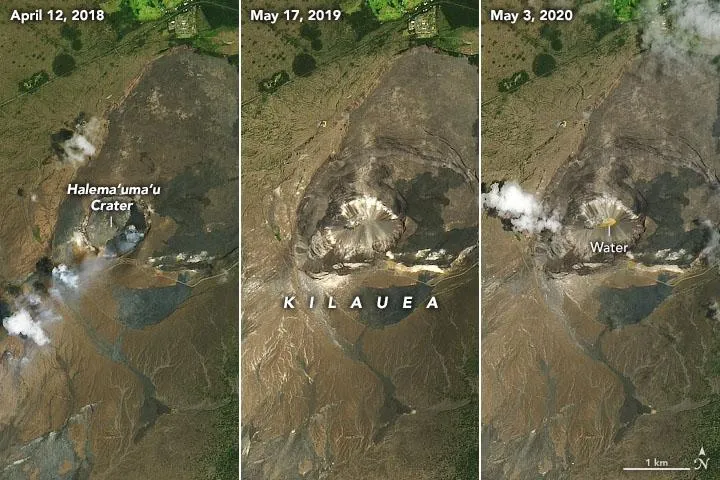NASA Photos Reveal a Lake of Water—Not Lava—on Kīlauea Volcano
NASA’s Landsat 8 satellite captured the images, which show water collecting at the summit of Hawai’i’s Kīlauea
/https://tf-cmsv2-smithsonianmag-media.s3.amazonaws.com/filer/dc/f6/dcf60fed-cb26-48ef-97bc-bf55b2cc8679/lake.jpg)
In 2018, Hawai’i’s Kīlauea volcano erupted dramatically in the spring and summer. Huge plumes of ash, smog, and lava bombs spurted from its fissures. Flowing lava permanently altered the surrounding landscape and destroyed more than 700 homes, Brigit Katz reported for Smithsonian magazine at the time. Things have cooled off since then and earlier this month, new satellite images from NASA show something else forming on Kīlauea’s summit: a huge, rust-colored lake filled with water, not lava.
Photos taken by NASA’s Landsat 8 satellite show that water has been collecting in the Halema‘uma‘u crater in the summit of Kīlauea since July 2019, the Earth Observatory announced in a statement. This marks the first recorded instance of a pond of water of this size appearing in the crater, Aristos Georgiou reports for Newsweek.
Kīlauea, a 4,091-foot-tall shield volcano, is located on the southeastern side of the island of Hawai’i. The volcano erupted continuously from 1983 until 2018, when it emitted its largest eruption in at least 200 years, according to the United States Geological Survey.
When Kīlauea erupted in 2018, its lava pool emptied and the floor of its caldera—the large, basin-shaped depression that surrounds its vents—collapsed. This event created a much-deeper Halema‘uma‘u crater that reaches 920 feet below the former level of the crater floor, per the statement.

Now, water is pooling in a pond in the lowest part of the crater. This new lake spans the length of five football fields and reaches about 100 feet deep. The water’s rusty brown color comes from chemical reactions taking place in the water, per Newsweek.
Water is collecting in the crater because it’s located below the water table level, according to Don Swanson, a volcanologist at the Hawaiian Volcano Observatory quoted in the statement. According to Encyclopedia Britannica, the water table is the upper level of underground surfaces that are permanently saturated with groundwater.
“We know that the crater floor dropped a little more than 70 meters below the water table in 2018. Any time that you punch a hole below the level of the water table, water is eventually going to come in and fill that hole,” says Swanson.
As Ryan F. Mandelbaum reports for Gizmodo, the pooling of water in Kīlauea’s crater might lead to even more explosive eruptions in the future. When water dissolves into magma, it can create a build-up of steam and pressure, which can lead to dramatic explosions.
More explosive eruptions would not be totally surprising, given Kīlauea’s history. As Swanson points out, about 60 percent of Kīlauea’s eruptions in the last 2,500 years have been explosive ones. Besides the 2018 eruption, the relatively calm lava flows witnessed in the last 200 years were the exception, not the norm.
“We do not want to be alarmist, but we also need to point out to the public that there is an increasing possibility of explosive eruptions at Kilauea,” says Swanson. “Is the volcano in the process of reverting back to an explosive period that may last for centuries? Or is this just a little blip, and we are going to return to quiet lava flows like we had during the 19th and 20th centuries? Only time will tell.”
/https://tf-cmsv2-smithsonianmag-media.s3.amazonaws.com/accounts/headshot/nora.png)
/https://tf-cmsv2-smithsonianmag-media.s3.amazonaws.com/accounts/headshot/nora.png)